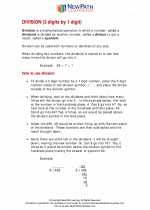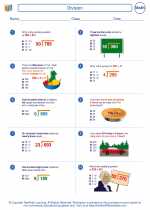Dividend
In mathematics, a dividend is a number that is divided by another number. In the division equation dividend ÷ divisor = quotient, the dividend is the number being divided. It is the total quantity or amount that is to be divided into equal parts.
Example:
If we have 15 ÷ 3, then 15 is the dividend. The number 3 is the divisor, and the quotient is the result of the division, which in this case is 5.
Study Guide:
- Understanding the Concept: Make sure to understand the basic concept of division and how the dividend, divisor, and quotient relate to each other.
- Practice Problems: Solve various division problems to get comfortable with identifying the dividend in different scenarios.
- Real-life Examples: Look for real-life examples of division and identify the dividends in those examples. For instance, if you have 20 cookies and want to divide them among 4 friends, 20 would be the dividend in this scenario.
- Word Problems: Practice solving division word problems to understand how dividends are used in practical situations.
Understanding the concept of dividends is crucial for mastering division and other related mathematical operations.
.◂Math Worksheets and Study Guides Sixth Grade. Division
Study Guide Division
Division  Worksheet/Answer key
Worksheet/Answer key Division
Division  Worksheet/Answer key
Worksheet/Answer key Division
Division  Worksheet/Answer key
Worksheet/Answer key Division
Division 

 Worksheet/Answer key
Worksheet/Answer key
 Worksheet/Answer key
Worksheet/Answer key
 Worksheet/Answer key
Worksheet/Answer key

The resources above cover the following skills:
Connections to the Grade 6 Focal Points (NCTM)
Number and Operations: Students' work in dividing fractions shows them that they can express the result of dividing two whole numbers as a fraction (viewed as parts of a whole). Students then extend their work in grade 5 with division of whole numbers to give mixed number and decimal solutions to division problems with whole numbers. They recognize that ratio tables not only derive from rows in the multiplication table but also connect with equivalent fractions. Students distinguish multiplicative comparisons from additive comparisons.